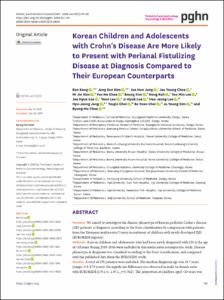Korean Children and Adolescents with Crohn's Disease Are More Likely to Present with Perianal Fistulizing Disease at Diagnosis Compared to Their European Counterparts
- Keimyung Author(s)
- Jang, Hyo Jeong
- Department
- Dept. of Pediatrics (소아청소년학)
- Journal Title
- Pediatric Gastroenterology, Hepatology & Nutrition
- Issued Date
- 2020
- Volume
- 23
- Issue
- 1
- Keyword
- Crohn disease; Fistula; Abscess; Paris; Classification; Phenotype; Korea; Europe; Pediatrics; Inflammatory bowel disease
- Abstract
- Purpose:
We aimed to investigate the disease phenotype of Korean pediatric Crohn's disease (CD) patients at diagnosis according to the Paris classification by comparison with patients from the European multicenter 5-years recruitment of children with newly developed IBD (EUROKIDS registry).
Methods:
Korean children and adolescents who had been newly diagnosed with CD at the age of <18 years during 2013–2016 were included in this multicenter retrospective study. Disease phenotype at diagnosis was classified according to the Paris classification, and compared with the published data from the EUROKIDS study.
Results:
A total of 255 patients were included. The median diagnosis age was 14.7 years (range, 0.8–17.9 years). No significant difference was observed in male-to-female ratio with EUROKIDS (1.9:1 vs. 1.45:1, p=0.062). The proportion of children aged <10 years was significantly lower in Koreans (7.1% vs. 19.6%, p<0.001). Colonic disease was less prominent (10.0% vs. 27.3%, p<0.001), while upper GI involvement was more prominent in Korean children (59.3% vs. 46.2%, p<0.001). The proportion with perianal fistulizing disease at diagnosis was significantly higher in Korean patients (44.8% vs. 8.2%, p<0.001). A separate analysis of Korean patients revealed that perianal fistulizing disease at diagnosis was positively associated with male sex and body mass index z-score (odds ratio [OR]=2.12, 95% confidence interval [CI]=1.20–3.76, p=0.010; and OR=1.29, 95% CI=1.05–1.58, p=0.015, respectively).
Conclusion:
Approximately half of pediatric CD patients in Korea present with perianal fistulas and/or abscesses at diagnosis, which is a distinct feature of CD in Korean children and adolescents compared to their European counterparts. An underlying genetic difference between ethnicities may play a role in this expression of different phenotypes in pediatric CD.
- Keimyung Author(s)(Kor)
- 장효정
- Publisher
- School of Medicine (의과대학)
- Citation
- Ben Kang et al. (2020). Korean Children and Adolescents with Crohn’s Disease Are More Likely to Present with Perianal Fistulizing Disease at Diagnosis Compared to Their European Counterparts. Pediatric Gastroenterology, Hepatology & Nutrition, 23(1), 49–62. doi: 10.5223/pghn.2020.23.1.49
- Type
- Article
- ISSN
- 2234-8840
- Source
- https://www.pghn.org/DOIx.php?id=10.5223/pghn.2020.23.1.49
- Appears in Collections:
- 1. School of Medicine (의과대학) > Dept. of Pediatrics (소아청소년학)
- 파일 목록
-
-
Download
 oak-2020-0148.pdf
기타 데이터 / 711.65 kB / Adobe PDF
oak-2020-0148.pdf
기타 데이터 / 711.65 kB / Adobe PDF
-
Items in Repository are protected by copyright, with all rights reserved, unless otherwise indicated.